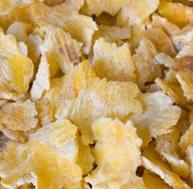Corn Processing for Reduced Methane Production
March 2015
 Beef producers often process grain to increase starch (energy) utilization in finishing diets and improve feed efficiency. One of the most effective ways to increase the extent of starch digestion is by increasing the rate of ruminal digestion.
Beef producers often process grain to increase starch (energy) utilization in finishing diets and improve feed efficiency. One of the most effective ways to increase the extent of starch digestion is by increasing the rate of ruminal digestion.
The pericarp or seed coat is often resistant to bacterial attachment and enzymatic degradation by ruminal bacteria. During mastication, whole grain can be physically altered to improve starch digestibility. However, optimum digestibility or energy utilization typically does not occur unless other mechanical means are used to improve starch utilization.
Steam-flaking, high moisture ensiling, and reducing of particle size (grinding or rolling) are the most common grain processing methods to improve starch digestibility. Ruminal starch disappearance is approximately 77%, 90% and 86% for dry-rolled, high-moisture, and steam-flaked corn (respectively) while total tract starch digestibility is approximately 95%, 99%, and 99% (respectively). The improvement in starch digestibility is usually accompanied by the improvement in feed efficiency if ruminal acidosis can be controlled.
When grain is intensely processed there is often a greater proportion of ruminal propionate compared with acetate. If acetate is formed as an end-product of starch digestion, CO2 is also produced during the process and available for ruminal methanogens to reduce to methane. However, if propionate is the end-product, methane production is reduced and energy is not lost. These concepts have been demonstrated using several different methods.
- A theoretical fermentation balance that includes VFA's and organic matter fermented in the rumen allows researchers to calculate the amount of methane produced compared with what was digested in the rumen.
- Metabolizable energy for grain with different corn processing methods can be predicted by measuring carcass energy retention or estimating energy retention from average daily gain and feed intake. If less methane is produced there is a greater amount of energy used by the animal for body weight gain.
- Direct measurement of methane production. Methane can be measured directly by animals in respiration chambers. In experiments that have directly measured the difference between dry-rolled corn and steam-flaked corn, there was approximately 20% less methane produced daily for animals consuming steam-flaked corn.
Methane can also be produced by microorganisms in the feces or manure. When a less digestible feedstuff is fed there is more substrate (often starch in finishing diets) that can be used by microorganisms to produce methane.
Intensive processing methods reduce both ruminal methane production and methane produced in the manure.Matthew Luebbe
Asst. Professor, Animal Science
Panhandle Research & Extension Center
University of Nebraska–Lincoln
References
- Cooper, R.J., C.T. Milton, T.J. Klopfenstein, T.L. Scott, C.B. Wilson, R.A. Mass. 2002. Effect of corn processing on starch digestion and bacterial crude protein flow in finishing cattle. J. Anim. Sci. 75:797-804.
- Corona, L., F.N. Owens, R.A. Zinn. 2006. Impact of corn vitreousness and processing on site and extent of digestion by feedlot cattle. J. Anim. Sci. 84:3020-3031.
- Hales, K.E., N.A. Cole, J.C. MacDonald. 2012. Effects of corn processing method and dietary inclusion of wet distillers grains with solubles on energy metabolism, carbon-nitrogen balance, and methane emissions of cattle. J. Anim. Sci. 90:3174-3185.
- Huntington, G.B. 1997. Starch utilization by ruminants: from basics to the bunk. J. Anim. Sci. 75:852-867.
- McAllister, T.A., H.D. Bae, G.A. Jones, K.J. Cheng. 1994. Microbial attachement and feed digestion in the rumen. J. Anim. Sci. 72:3004-3018.